|
To perform any operations with an individual account, you need to find it in the system
using the Search utility in the navigation menu. From the search results page you can:
Viewing User and Account Information
To view details of a particular user or account:
- Find the account using the Search utility.
- Click the username to view contact info and billing info.
- Click the account ID to view account details.
- Click the View icon in the Balance column to view balance details.
Viewing Account Admin Notes (available in version 2.3.1 beta 4 and higher)
Admins can view/post notes about particular user accounts by doing the following:
- Find the account using the Search utility.
- Click the Account ID to go to the account details:

- Click the Notes link in the Control Panel User section to view/post admin notes
for this account.
- On the page that appears, enter a note in the note body and click the add a note button.
Here you can also view notes added before.
Add Custom Jobs (available in version 2.3.1 beta 4 and higher)
This feature allows you to track the additional services you offer to your customers. This
could be any type of jobs such as web design and development, installations, support, or
even marketing services.
You also have a user interface to view the custom jobs performed by your hosting administrator.
It's available under Support Center -> Custom Jobs.
A custom job consists of tasks, each with its own duration in hours and rate per working hour.
To open the Custom Jobs page for a particular account:
- Find the account using the Search utility.
- Click the Account ID to go to the account details:

- Click Custom Jobs in the Control Panel User section:

In the bottom frame, the Custom Jobs form will appear.
- Enter the description of the custom job and click the button:
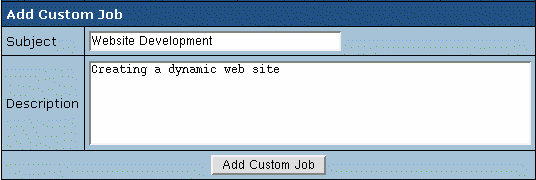
The custom job will appear in the list right above the form you have filled out.
- Click the ID of the custom job you have just created. You will see the details and a
form to add tasks to the custom job.
- Add a task:
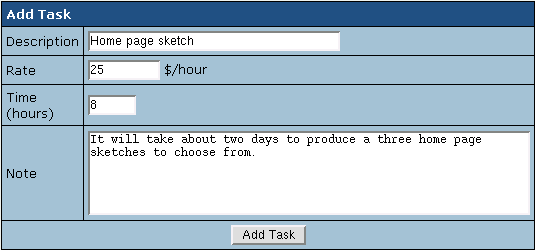
- Use controls to set the status of the custom job:
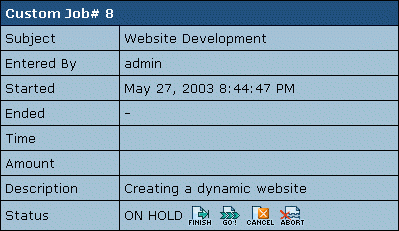
- Go! - to mark the job as active
- On Hold - to mark the job as pending
- Cancel - to mark the job as stopped
- Finish - to mark the job as completed
- Abort - to mark the job as aborted. This won't delete the job from the list
Custom job entries will be visible by your customers on Support Center -> Custom Jobs.
Crediting Accounts
Credited amounts are never added to credit card balances. Hosts of America can't put money
on credit cards. Instead, credited amounts are put on the account balance.
To credit a fixed amount to an account:
- Find the account using the Search utility.
- Click the Credit icon in the Billing column.
- Enter the amount:
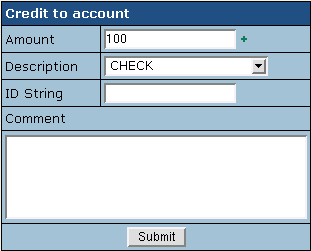
- Amount: don't enter negative amounts; instead, use the debit utility.
- Description: the reason for crediting the account.
- ID String: the explanation to the transaction that will show up in the invoice and the balance statement.
- Comment: this comment won't show to users.
Changing Billing Period Starting Date
(version 2.08 and higher)
To change or reset the beginning of account's billing period:
- Find the account using the Search utility.
- Click the Date icon in the Billing column.
- Enter the starting date of the next billing period.
- Click Submit.
Be very cautious when using this feature. Changing the billing
period starting date may result in major problems:
- If you shift the period starting date backwards, the
client will be charged the recurrent fees twice for the
overlapping days (for the remainder of the old period AND
for the new interval). For instance, the initial one month billing period started on November 11.
If on November 26 you set the date to October 2, the system will:
- Refund half of all the recurrent fees for the interrupted billing period.
- Charge the recurrent fees for October 2 - November 2
- Charge the recurrent fees for November 2 - December 2
Thus, most likely, you will want to credit the extra
charged amount back to user's account.
Note that traffic won't be reset. User control panel will show the
traffic that was used from the billing date you have set till the
present.
- If you shift the starting date forward, you will interrupt and close
the current billing period which will cause the refunds of all
recurrent fees prorated to the time left to the end
of the billing period. The next payment interval, however,
will start only on the date that you set. This way, you
will create a gap between the billing periods. The system
does not charge the customer for the time gap. The
customers are only charged the recurrent fee for the resources
like traffic or MySQL Quota that they actually use up. Also,
if a user purchases some resources during the gap period,
the system will charge the recurrent fee for these resources.
However, it will calculate the price from the moment of
purchase till the end of the new billing period. Say, you
close the current billing period on November 11 and set
the new starting date to December 1 (with a one-month payment
interval). This way, the user does not pay any recurrent
fees the remaining days of November. Still, if a user
buys a resource on November 20, he/she will be charged the
recurrent fee for the interval of 40 days (November 20 -
January 1).
- If you set the same billing date for many customers, the
system may become overloaded on this billing day.
Debiting Accounts
When you debit a check payment user, the amount is
subtracted from the account balance. When you debit
a credit card payment user, the amount is first subtracted
from the account balance, and when the credit limit is reached,
all the negative balance is charged to the credit card.
Once you have debited an account, you can't put the money back
to the credit card, you can only credit the account balance
or send this amount by check.
To debit an account:
- Find the account using the Search utility.
- Click the Debit icon in the Billing column.
- Select from multiple debit options:
- One-time debit
Debit account once.

Description: the title of the charge displayed in user' invoice and balance statement.
Note: the comment displayed in small font in user' invoice and balance statement.
Price: debit amount.
E-mail invoicing send a separate e-mail invoice for this debit.
Include taxes apply taxes to this debit.
- Month based debit:
Debit account every month for regular premium services.
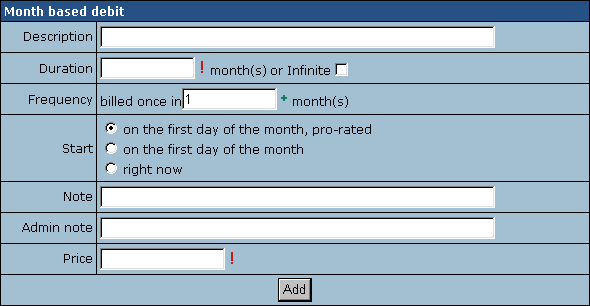
Description: the title of the charge displayed in user' invoice and balance statement.
Duration: when this period expires,
debit charges are discontinued.
Frequency: the charge cycle; leave 1 to charge the account every month.
Start:
- on the first day of the month, pro-rated: account is
debited on the 1st of each charge cycle, except for the first time.
The first debit charge is conformed with the time left to the end of the
charge cycle.
Example: enabled - 20 April; frequency - 2 months; price - $6
On 20 April the first debit charge will be applied. Account will be
charged $4 ($3 for May + $1 for ten days of April). The next debit charge
($6) will be applied on 1 June.
- on the first day of the month: account is debited on the 1st
of each charge cycle. The whole debit amount is charged without being
pro-rated.
Example: enabled - 20 April; frequency - 2 months; price - $6
On 20 April the first debit charge will be applied. Account will be charged
$6. Next $6 charge will occur on 1 June.
- right now: account is debited on the day you enabled
it each charge cycle.
Example: enabled - 20 April; frequency - 2 months; price - $6
On 20 April the account will be debited $6. Next $6 charge will occur
on 20 June, then on 20 August, and so on.
Description: the title of the charge displayed in user' invoice and balance statement.
Admin note: this note won't be visible to the user, for admin's use.
Price: debit amount.
- Billing period based debit
Debit account at the beginning of each billing period for
regular premium services.

Description: the title of the charge displayed in user' invoice and balance statement.
Note: the comment displayed in small font in user' invoice and balance statement.
Admin note: this note won't show to the user.
Price: debit amount.
Active debiting rules are listed at the bottom of the page:
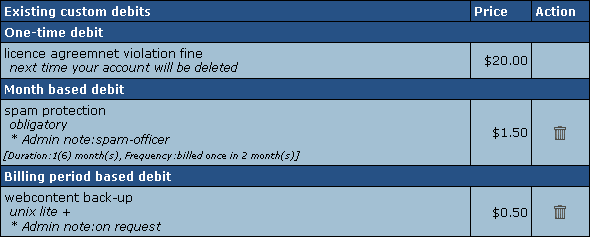
Enlarging Credit Limits
To enlarge or reduce credit limit for a particular account by a fixed amount:
- Find the account using the Search utility.
- Click the credit limit value in the Credit column.
- On the page that appears, enter the amount above plan's credit limit value. Entering a
negative amount will decrease the Credit Limit. For example, the Credit Limit for the plan
is $10. To make it $12 for a specific account, enter 2. To make it $8 for a specific account,
enter -2.
- Click Enlarge.
Resetting credit limit
(version 2.09.6 and higher)
Sometimes you need to reset credit limits for all accounts to the plan's default value.
To do it in one go, do the following:
- Select Other in the E. Manager menu.
- Click Reset Credit Limit to cut down all the personal credit enlargements in your customers' accounts.
Note: Remember that resetting credit limit for all accounts will set all enlarged
credit limits, if any, to default in all accounts under all plans. This will show as zero
on the Search result page in the Credit Limit section, where zero is the difference
from the default plan value.
Logging In As User
To log into user's control panel:
- Find the account using the Search utility.
- Click the Login icon in the Controls column.
Suspending and Resuming Accounts
To suspend or resume an individual account:
- Find the account using the Search utility.
- Click the Suspend or Resume icon in the Controls column.
When you suspend account:
- The current billing period is closed.
- The account is refunded all the recurrent fees for the unused resources
prorated to the period left to the end of the interrupted billing period
* The "Full refund" message in the account Online Invoice implies that it isn't
adjusted to the refund percentage.
When you resume account:
- A new billing period is opened.
- The account is accrued all the outstanding recurrent fees for a new billing period.
Owners of suspended accounts get e-mail notifications, and can view their invoices
and billing profiles. The suspended account mail system is restricted by:
-d (sets no password changing flag)
-p (sets no pop access flag)
-w (sets no web mail access flag)
-i (sets no imap access flag)
-b (sets bounce mail flag)
-r (sets no external relay flag)
Note: If you resume an expired trial account, it will be suspended
again in some 24 hours. To bring this account into operation,
the trial user should create a valid billing profile.
Deleting Accounts
To delete an individual account permanently:
- Find the account using the Search utility.
- Suspend the account.
- Make sure all outstanding amounts are settled.
- Click the Delete icon in the Controls column.
Sending Mass Mails (Newsletters)
To send a newsletter to a group of customers:
- Select accounts using the Search
utility.
- Click the Mass Mail link at the bottom of the search results page:

- Compose the message:
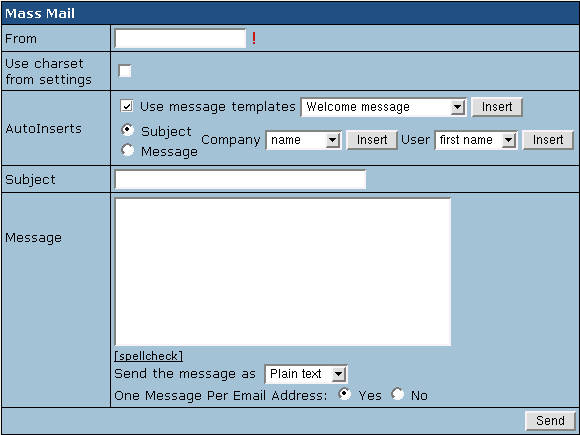
- From: enter one of your e-mail addresses to send the message from.
- Use charset from settings: message encoding will be set based
on the language selected by the customer.
- Use Message Templates: check this box to e-mail system notifications.
In this case, any info you enter in the message body will be ignored.
- Autoinserts (version 2.09 and higher): Use this feature to convert
your mass mails into personalized letters. When composing a mass mail,
insert generic variables that will be replaced with individual recipient's
name, e-mail address, etc.
- Subject: enter a subject of the message.
- Message: enter a message to be sent to all customers. Remember:
if you use message templates, this message will be ignored.
- Spellcheck: version 2.3 and higher allows checking your mail
messages for spelling. To do it:
- Click the spellcheck link under the message field. Pop-up window
shows with misspelled words, if any, being underlined:
- Point your mouse to a misspelled word and a number of suggestions shows.
- Choose correct variants and click Done.
- Send the message as (version 2.11 and higher): Select HTML
to apply formatting to your message, e.g.:
<i>text in italic</i><br>
<b>text in bold</b>
<ul>
<li>unordered list (bullet)</li>
<li>unordered list (bullet)</li>
</ul>
- One Message Per Email Address:
-Yes - only one message will be sent to an address,
regardless of how many accounts use it.
-No - the message is sent to every account's e-mail
address even if it is the same for different accounts.
|